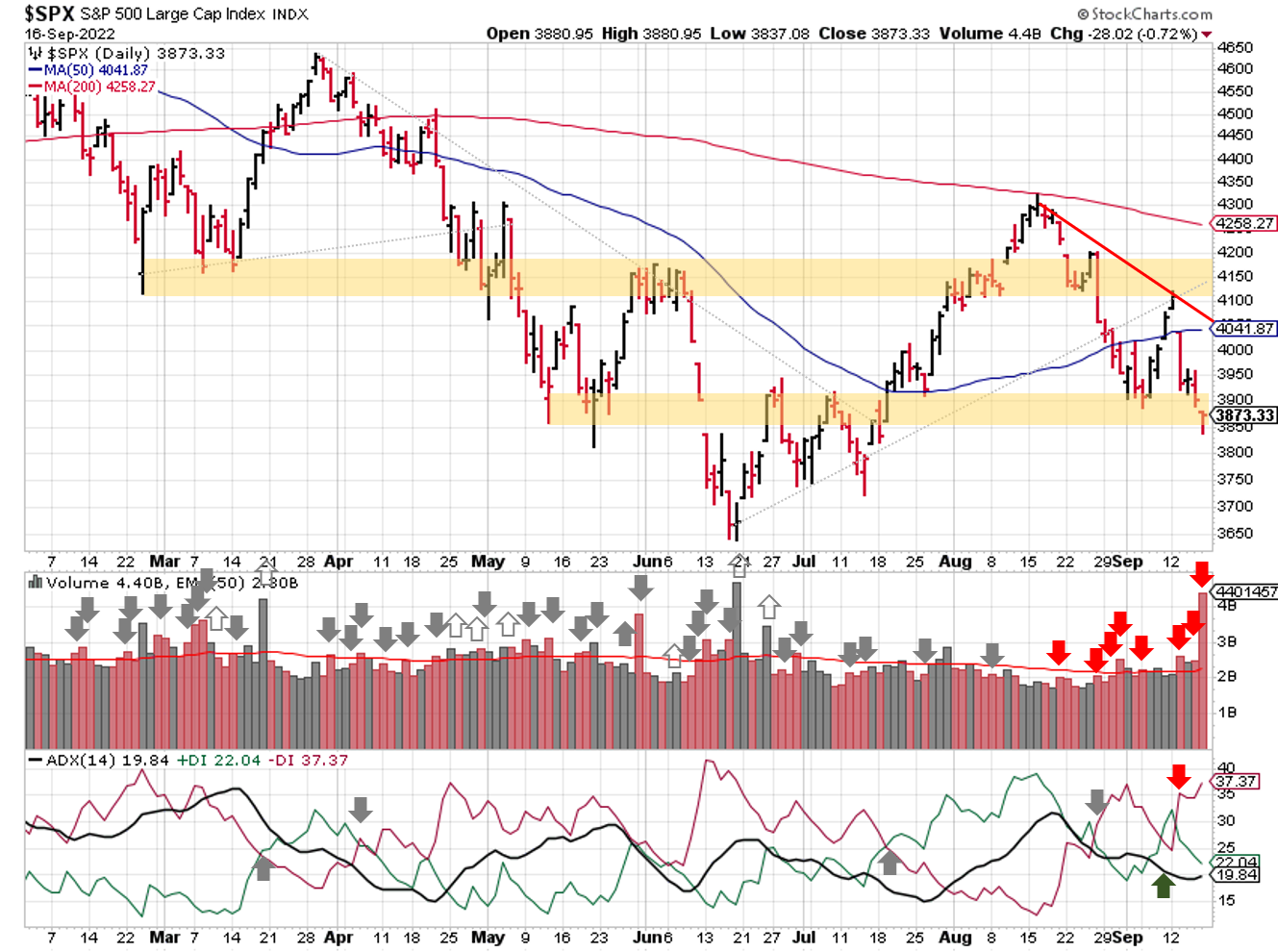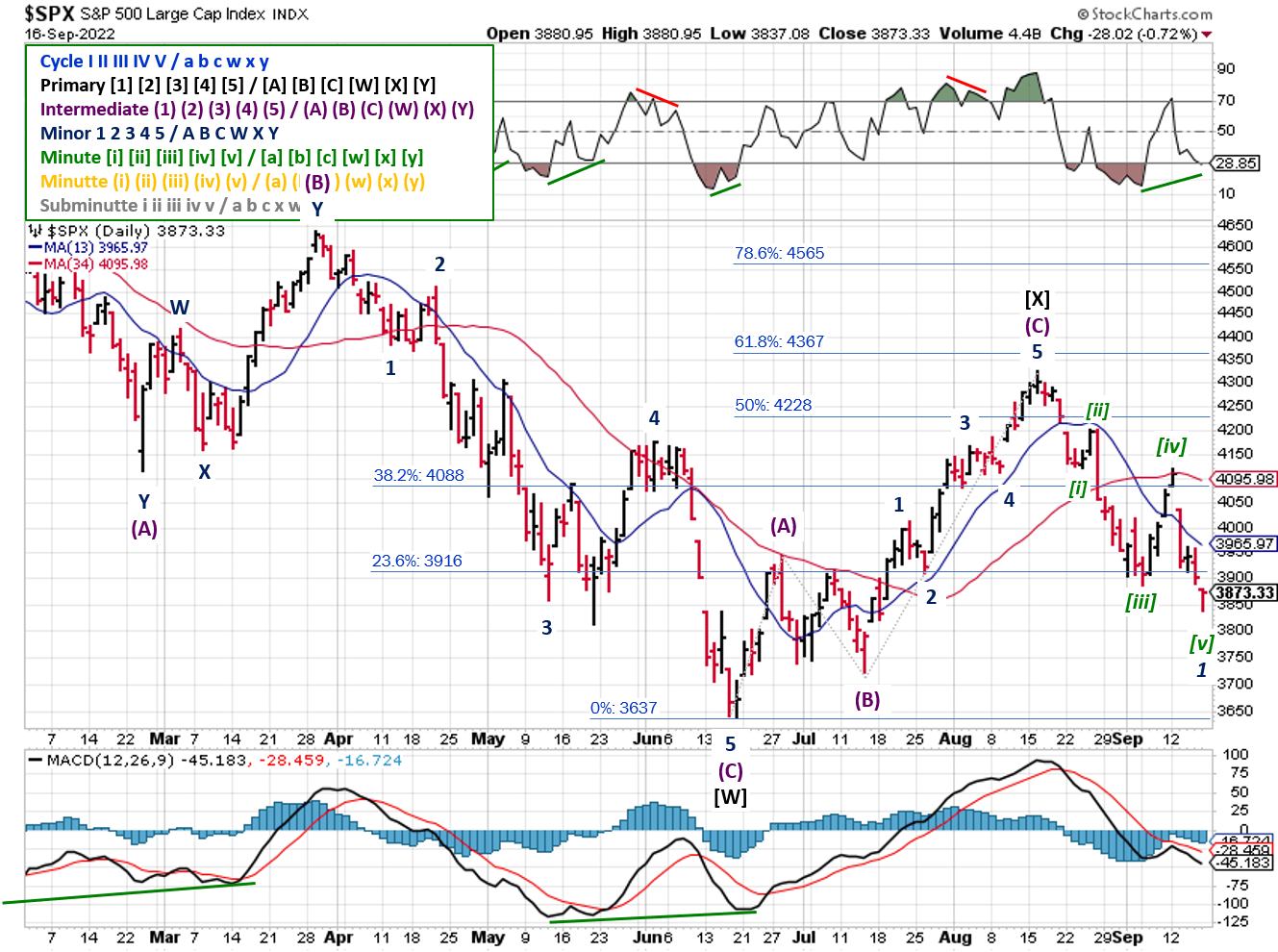Stock Market Outlook
For The Week Of September 18th = Downtrend
INDICATORS
-
ADX Directional Indicators: Downtrend
Price & Volume Action: Downtrend
Elliott Wave Analysis: Downtrend
The S&P500 ($SPX) fell 4.8% last week, succumbing to worse than expected inflation data and option expiration. The index fell from a prior trendline, the traditional technical pattern of retesting prior support/resistance.
2022-09-18-SPX Trendline Analysis - Daily
Thanks to Tuesday's big drop, the ADX directional indicators flipped back to bearish, as did price & volume. The index gaped down to the 50-day and kept going on higher trading volume, and followed that up with 2 more days of institutional selling Thursday and Friday.
Elliott Wave still shows the downtrend in progress. The chart below includes a few adjustments to wave labels, but still tracks the Double-Three corrective pattern. At this point, the SPX completed the initial "flat" segment in mid-June, and 3-waves up in mid-August qualifies for the next "any 3-wave pattern" segment.
Now comes the hard part, as any corrective pattern is possible is the Double-Three remains valid. The index could experience another "flat" pattern, a traditional "zigzag" pattern, or something else. In all cases, there's a very high probability the SPX falls below the June low.
2022-09-18- SPX Elliott Wave Analysis - Daily - Primary Y
COMMENTARY
August CPI data disappointed many market participants before the stock market opened on Tuesday. The CPI index rose 0.1% from July, while year-over-year data showed annual inflation fell slightly to +8.3%. Core CPI increased 0.6% from July, with the year-over-year reading at 6.3% (July's y-o-y figure was 5.9%).
August producer prices were a bit better, but not by much. Wednesday's release showed PPI dropped 0.1% month-over-month, while the year-over-year reading remained constant at 8.7%. Core PPI rose 0.2% m-o-m, with the y-o-y figure showing an increase of 5.6%.
Retail spending data came out Thursday, and continued to show a weakening consumer. And Friday's quadruple witching day didn't disappoint, in terms of volatility and trading volume.
I wasn't expecting CPI to have such a dramatic impact on the market, but it appears that investors and traders drank too much "peak inflation" kool-aid and had to readjust their hedges ahead of Friday's option expiration.
To be fair, I also thought we had seen a peak in inflation data. Most narratives over the past 3 months have said that inflation had peaked, the market had already accounted for all the rate hikes, the end is near for this Fed hiking cycle, buy the dip, etc.
But the bond market continues to signal more risk in the near term, peak inflation or not (i.e. it remains steeply inverted). And corporate earnings still have NOT priced in the impact of higher inflation (i.e. slowing retail spending). So the market sell-off itself wasn't so surprising.
This week, the U.S. Fed is set to hike interest rates again; Fed watchers expect another 0.75% increase. There's also a slew of housing data set to be released Monday through Wednesday, and it's likely adds to the case for an ongoing economic slowdown (despite inflation).
Best To Your Week!
P.S. If you find this research helpful, please tell a friend. If you don't, tell an enemy.
Sources: Bloomberg, CNBC, Hedgeye, U.S. Bureau of Labor Statistics
Share this Post on:

How to Make Money in Stocks: A Winning System in Good Times and Bad.
It's one of my favorites.
I regularly share articles and other news of interest on:
Twitter (@investsafely)
Facebook (@InvestSafely)
LinkedIn (@Invest-Safely)
Instagram (@investsafely)
Invest Safely, LLC is an independent investment research and online financial media company. Use of Invest Safely, LLC and any other products available through invest-safely.com is subject to our Terms of Service and Privacy Policy. Not a recommendation to buy or sell any security.
Charts provided courtesy of stockcharts.com.
For historical Elliott Wave commentary and analysis, go to ELLIOTT WAVE lives on by Tony Caldaro. Current counts can be found at: Pretzel Logic, and 12345ABCDEWXYZ
Once a year, I review the market outlook signals as if they were a mechanical trading system, while pointing out issues and making adjustments. The goal is to give you to give you an example of how to analyze and continuously improve your own systems.
- 2015 Performance - Stock Market Outlook
- 2016 Performance - Stock Market Outlook
- 2017 Performance - Stock Market Outlook
- 2018 Performance - Stock Market Outlook
- 2019 Performance - Stock Market Outlook
- 2020 Performance - Stock Market Outlook
IMPORTANT DISCLOSURE INFORMATION
This material is for general communication and is provided for informational and/or educational purposes only. None of the content should be viewed as a suggestion that you take or refrain from taking any action nor as a recommendation for any specific investment product, strategy, or other such purpose. Certain information contained herein has been obtained from third-party sources believed to be reliable, but we cannot guarantee its accuracy or completeness.
To the extent that a reader has any questions regarding the applicability of any specific issue discussed above to his/her individual situation, he/she is encouraged to consult with the professional advisors of his/her choosing. Invest Safely, LLC is not a law firm, certified public accounting firm, or registered investment advisor and no portion of its content should be construed as legal, accounting, or investment advice.
The material is not to be construed as an offer or a recommendation to buy or sell a security nor is it to be construed as investment advice. Additionally, the material accessible through this website does not constitute a representation that the investments described herein are suitable or appropriate for any person.
Hypothetical Presentations:
Any referenced performance is “as calculated” using the referenced funds and has not been independently verified. This presentation does not discuss, directly or indirectly, the amount of the profits or losses, realized or unrealized, by any reader or contributor, from any specific funds or securities.
The author and/or any reader may have experienced materially different performance based upon various factors during the corresponding time periods. To the extent that any portion of the content reflects hypothetical results that were achieved by means of the retroactive application of a back-tested model, such results have inherent limitations, including:
Model results do not reflect the results of actual trading using assets, but were achieved by means of the retroactive application of the referenced models, certain aspects of which may have been designed with the benefit of hindsight
Back-tested performance may not reflect the impact that any material market or economic factors might have had on the use of a trading model if the model had been used during the period to actually manage assets
Actual investment results during the corresponding time periods may have been materially different from those portrayed in the model
Past performance may not be indicative of future results. Therefore, no one should assume that future performance will be profitable, or equal to any corresponding historical index.
The S&P 500 Composite Total Return Index (the "S&P") is a market capitalization-weighted index of 500 widely held stocks often used as a proxy for the stock market. Standard & Poor's chooses the member companies for the S&P based on market size, liquidity, and industry group representation. Included are the common stocks of industrial, financial, utility, and transportation companies. The S&P is not an index into which an investor can directly invest. The historical S&P performance results (and those of all other indices) are provided exclusively for comparison purposes only, so as to provide general comparative information to assist an individual in determining whether the performance of a specific portfolio or model meets, or continues to meet investment objective(s). The model and indices performance results do not reflect the impact of taxes.
Investing involves risk (even the “safe” kind)! Past performance does not guarantee or indicate future results. Different types of investments involve varying degrees of underlying risk. Therefore, do not assume that future performance of any specific investment or investment strategy be suitable for your portfolio or individual situation, will be profitable, equal any historical performance level(s), or prove successful (including the investments and/or investment strategies describe on this site).




